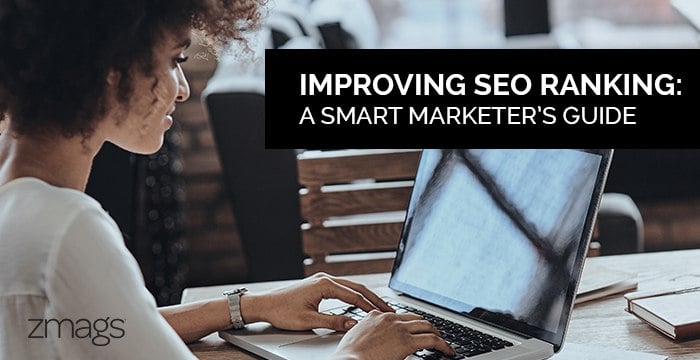How to Improve SEO Ranking (In 4 Steps)


Cait is a Senior Vice President, Product and Customer Experience. She's an experienced product leader adept at working with cross-functional teams to launch products that meet and exceed the needs of eCommerce brands.
Cait Porte
Creator by Zmags SVP, Product & Customer Experience
For an eCommerce digital marketer, success is usually measured by revenue. Everyone’s boss wants to see higher conversions, a higher average order value, more return customers, etc. But while conversions can seem like the end-all, be-all, the smart marketer knows there’s more to it. For a digital marketer focused on brand authority, SEO ranking is just as important.Improve SEO for Increased Conversions
When your website is optimized for organic search, your brand reaches a wider and better audience. When you have a wider audience, you ultimately have a larger pool of potential customers. Think of it this way – if the average eCommerce conversion rate is about 2%, for every 1000 new visitors to your site 20 of them will make a purchase. While it can seem like a purely engagement metric booster, SEO can make a tangible difference in sales.
1. Diversify your content
When serving up rankings on the SERP (Search Engine Results Page), one of the elements taken into consideration is the quality of the content. A strong way to groom your website for search engine algorithms is through diversifying your content. Whether it’s adding a video to a blog post, or UGC to a long-form experience, we recommend mixing it up and incorporating a variety of rich content.
2. Bump Up the Word Count
Another way to improve content quality for SEO is to incorporate more text-heavy pages. When a search is initiated, Google is searching through crawlable text for relevant information. This means the more text you have, the higher you can rank. Content types like blog posts, editorial pieces, or interviews are a perfect way to provide large blocks of texts in a create and unique way. Because while we want Google to like your content, customers should too!
3. Keep it Fresh
Google prioritizes content that is current, up-to-date, and regularly refreshed. What this ultimately means is that digital marketers need to create high volumes of content quickly, in order to keep up. Whether it’s a constantly updated homepage, rotating trend pages, or a blog series, staying on top of your content production will yield significant SEO results.
4. Consider Heading Tagging
During a search, Google is measuring the relevancy of your page in the context of a user’s query. Heading tags (H1-H6) count towards this relevancy measurement, so the more strategic your headings are, the better your page will rank. Keep in mind what sort of keywords consumers use to search for products, and implement them in your H tagging.